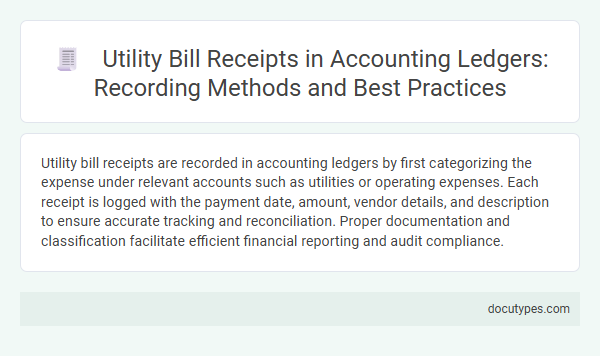Utility bill receipts are recorded in accounting ledgers by first categorizing the expense under relevant accounts such as utilities or operating expenses. Each receipt is logged with the payment date, amount, vendor details, and description to ensure accurate tracking and reconciliation. Proper documentation and classification facilitate efficient financial reporting and audit compliance.
Introduction to Utility Bill Receipts in Accounting
Utility bill receipts represent proof of payments made for services such as electricity, water, and gas. These receipts are essential documents for tracking and verifying utility expenses in accounting processes.
Recording utility bill receipts accurately in accounting ledgers ensures proper expense management and financial reporting. These entries help businesses monitor utility costs and maintain compliance with financial regulations.
Importance of Accurate Utility Bill Recording
Utility bill receipts are meticulously recorded in accounting ledgers to ensure precise expense tracking and financial transparency. Accurate recording of these receipts supports effective budget management and compliance with regulatory standards.
- Expense Verification - Recording utility bill receipts allows verification of actual expenses against budgeted amounts.
- Audit Trail - Proper documentation creates an audit trail necessary for internal reviews and external audits.
- Cash Flow Management - Timely entry of utility expenses helps maintain accurate cash flow statements and financial planning.
Maintaining accuracy in utility bill receipt recording strengthens overall financial integrity and operational efficiency.
Common Components of Utility Bill Receipts
Utility bill receipts are recorded in accounting ledgers by capturing essential transaction details to ensure accurate expense tracking. Proper documentation helps maintain clear financial records for periodic review and audit purposes.
- Vendor Information - The receipt lists the utility provider's name and contact details for verification and future correspondence.
- Billing Period - Specifies the time frame of service covered by the bill to match expenses with appropriate accounting periods.
- Total Amount Due - Shows the exact payable amount, including taxes and fees, for accurate ledger entry and payment processing.
Methods for Recording Utility Bill Receipts in Ledgers
How are utility bill receipts recorded in accounting ledgers? Utility bill receipts are typically recorded as expenses in the accounting ledger to reflect the cost incurred for utilities during a specific period. These receipts are documented by debiting the utility expense account and crediting the accounts payable or cash account, depending on payment status.
Manual vs. Digital Recording Techniques
Utility bill receipts are recorded in accounting ledgers through either manual or digital techniques. Manual recording involves physically entering data from paper receipts into ledger books or spreadsheets.
Digital recording uses software to automatically capture and categorize receipt information from scanned or emailed documents. Your choice between these methods impacts accuracy, efficiency, and record-keeping consistency.
Standardized Formats for Utility Bill Entries
| Aspect | Description |
|---|---|
| Standardized Format | Utility bill receipts are typically recorded in accounting ledgers using a consistent and standardized format. This includes clearly itemizing the date of the bill, the vendor or utility provider, the billing period, and the total amount due or paid. |
| Account Classification | Each utility bill is assigned to a specific expense account such as "Electricity Expense," "Water Expense," or "Gas Expense" to ensure accurate tracking and categorization. |
| Entry Details | Standard ledger entries include the debit to the utility expense account and a corresponding credit to accounts payable or cash, depending on whether the bill is paid immediately or outstanding. |
| Receipt Documentation | The receipt or invoice from the utility company should be attached or referenced in the accounting system to provide supporting documentation for audit and verification purposes. |
| Data Consistency | Maintaining a uniform entry format across all utility bills supports data consistency, simplifying reconciliation and financial analysis. |
| User Impact | You can enhance accuracy by following these standardized formats, improving the clarity and reliability of your financial records related to utilities. |
Best Practices for Categorizing Utility Bill Expenses
Utility bill receipts are recorded in accounting ledgers by first verifying the invoice details and matching them with the payment records. Best practices for categorizing utility bill expenses involve classifying them under operational or overhead costs, typically within accounts such as "Utilities Expense" or "Facility Costs." Proper categorization ensures accurate financial reporting and aids in budgeting and expense tracking for utility consumption.
Reconciliation of Utility Bill Receipts with Bank Statements
Utility bill receipts are recorded in accounting ledgers by matching the amounts paid with corresponding entries. Reconciliation with bank statements ensures accuracy and prevents discrepancies in financial records.
- Record the Utility Bill Receipt - Enter the utility bill receipt details into the accounts payable ledger upon receipt.
- Match Payments with Bank Statements - Compare the payment amounts and dates on the utility bill receipts to the bank statement transactions.
- Resolve Discrepancies - Investigate and adjust any differences between the utility bill receipts and bank statement entries to maintain accurate records.
Audit Trail and Documentation Requirements
Utility bill receipts are recorded in accounting ledgers by first verifying the invoice details and matching them against purchase orders and service agreements. Accurate entry of these receipts ensures the expenses are tracked and allocated to the correct accounting periods and cost centers.
Maintaining an audit trail requires proper documentation, including copies of the utility bills, payment vouchers, and authorization approvals. This documentation supports the legitimacy of the recorded transactions during audits and reconciliations. Compliance with regulatory standards demands that all entries are traceable and stored securely for future reference.
How Are Utility Bill Receipts Recorded in Accounting Ledgers? Infographic

